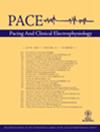一名儿童因运动诱发 1 型 Brugada 模式。
IF 1.7
4区 医学
Q3 CARDIAC & CARDIOVASCULAR SYSTEMS
Pace-Pacing and Clinical Electrophysiology
Pub Date : 2024-11-01
Epub Date: 2024-06-09
DOI:10.1111/pace.15024
引用次数: 0
摘要
运动负荷试验可揭示部分 Brugada 综合征患者表面心电图上的 1 型 Brugada 模式。儿童患者在运动测试中出现 1 型 Brugada 模式的情况并不常见。因此,运动试验在这一人群中的诊断率仍有待探索。我们介绍了一例运动诱发 1 型 Brugada 模式的 12 岁儿童心悸发作病例,并讨论了运动负荷试验在 Brugada 综合征患者诊断和风险分层中的作用的现有证据。本文章由计算机程序翻译,如有差异,请以英文原文为准。
Exercise-induced type 1 Brugada pattern in a child.
The exercise stress testing may unmask the type 1 Brugada pattern on the surface electrocardiogram in a portion of patients with Brugada syndrome. The occurrence of the type 1 Brugada pattern during an exercise test in pediatric patients is not common. Consequently, the diagnostic yield of the exercise test in this population is still to be explored. We present a case of exercise-induced type 1 Brugada pattern in a 12-year-old child with episodes of palpitations and discuss the available evidence on the role of the exercise stress test in the diagnosis and risk stratification of patients with Brugada syndrome.
求助全文
通过发布文献求助,成功后即可免费获取论文全文。
去求助
来源期刊

Pace-Pacing and Clinical Electrophysiology
医学-工程:生物医学
CiteScore
2.70
自引率
5.60%
发文量
209
审稿时长
2-4 weeks
期刊介绍:
Pacing and Clinical Electrophysiology (PACE) is the foremost peer-reviewed journal in the field of pacing and implantable cardioversion defibrillation, publishing over 50% of all English language articles in its field, featuring original, review, and didactic papers, and case reports related to daily practice. Articles also include editorials, book reviews, Musings on humane topics relevant to medical practice, electrophysiology (EP) rounds, device rounds, and information concerning the quality of devices used in the practice of the specialty.
 求助内容:
求助内容: 应助结果提醒方式:
应助结果提醒方式:


